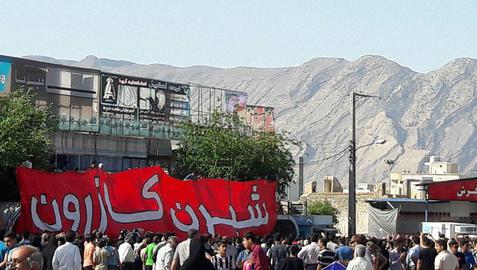An election campaign promise has led to unrest, chaos and bloodshed in Kazerun, a city in the southwest province of Fars. When Hossein Rezazadeh ran for parliament, one of his key campaign promises was to split the county — also called Kazerun — into two, winning him the vote. Now the city has seen days of violent clashes between protesters and police, and led to the deaths of three people, with many more injured. What was once a political tactic has now become a national security crisis.
Rezazadeh pledged to break Kazerun county, one of the most deprived counties in Fars province, into two, and establish a new county, Kuhchenar, which would become the 30th county in the province. Currently, Fars province has 29 counties. The creation of new counties is not without precedent, whether in the province or elsewhere in Iran. Politicians successfully lobbied for the creation of two counties in Fars, Khorrambid and Pasargad, home to the tomb of Cyrus the Great, for example. But never in the history of Fars province has the idea of setting up a new county generated so much controversy and so much opposition, or become a serious security issue.
The etymology of the word “Persia” comes from “Fars” — or “Pars” in old Persian. With an area of over 122,000 square kilometers, the province is the fifth largest in Iran, after Sistan and Baluchistan, Kerman, Yazd and Razavi Khorasan. Until 1937, it was part of the Southern Province that was comprised of Yazd, Abadeh, Shiraz, Estahban, Jahrom, Bandar Lengeh, Larestan, Bushehr, Bandar Abbas, Kerman and Jiroft counties.
In 1937, when the map of administrative divisions in Iran was redrawn, Fars became an independent province. In that year, the province had only four counties (shahrestan in Persian) — Shiraz, Abadeh, Fesa, and Larestan. The additional 25 counties were created by the breakup of existing ones. The most number of administrative divisions in the province, more than 204, have occurred at the level of rural districts (dehestan in Persian). During the same period, 51 districts (bakhsh in Persian, a level below shahrestan) were created as well.
The changes mostly occurred in the years since the 1979 Islamic Revolution, especially after the Law of Administrative Divisions was passed in 1983. The largest number of changes have occurred in the county of Larestan, and then in Shiraz and Mamasani counties, and all changes took place between 1988 and 1992.
Out of the 29 current counties, 10 were created before 1983 when the new law was passed. Following the 1937 law, interior ministers and cabinets took the decision to set up new divisions. Between 1983 and the early 1990s, 10 more counties were created.
Why New Administrative Divisions?
In effect, for many years Iran has been witnessing a number of “status upgrades” — for example, when a district is upgraded and becomes a county. But what has been driving these upgrades, and why have they happened so often after the Islamic Revolution and the birth of the Islamic Republic? A few major factors are at work.
One important factor is that creating new administrative areas can give underdeveloped areas a better chance for development. It is assumed that when a town becomes the capital of a county, it will receive a greater number of services and financial resources from the provincial and central governments.
The second reason officials might change the administrative status of a city, county, or district is to compensate for the remoteness of the area. When a place is far from administrative centers, residents are at a disadvantage when it comes to accessing services that administrations provide. This was the main factor in the creation of several counties, including Bavanat, Qir and Karzin, Farashband, Lamerd, Mehr, Rostam and Zarrin Dasht.
The third reason for these reforms can be for cultural and/or religious differences. For example, Gerash is a Shia-majority county, while Khonj is a Sunni county.
And, of course, these changes can be the result of political rivalries between towns. A capital town of a county will receive — or hope and expect to receive — more services and, of course, this can also produce attitudes of superiority, and to officials or residents believing their town is more entitled than another.
It is clear that the introduction of new administrative divisions or officials carving up existing counties and creating new boundaries can have complex and contentious political, cultural and religious implications. Despite this, until now, very few problems have arisen as a result of such changes. But Kazerun has been different, and the contentious plan to establish a new Kuhchenar county by splitting off parts of Kazerun county has resulted in violence and a degree of unrest that officials probably had not anticipated. Opponents of the plan say that breaking up Kazerun county would mean residents of the new county would benefit, while those living in the original county would suffer enormously. At the moment, Kazerun is the most underdeveloped county in Fars province, receiving little in the way of health, educational and cultural services. Given that they believe the situation will only deteriorate if the county is divided, it is no surprise that the people of the city of Kazerun do not willingly consent to the establishment of Kuhchenar.
More on the unrest in Kazerun:
Kazerun: The Most Underdeveloped City in Fars Province, May 18, 2018
Kazerun’s Bloody Protests, May 17, 2018
Kazerun Protests: More than a Local Dispute, April 24, 2018
visit the accountability section
In this section of Iran Wire, you can contact the officials and launch your campaign for various problems

























comments